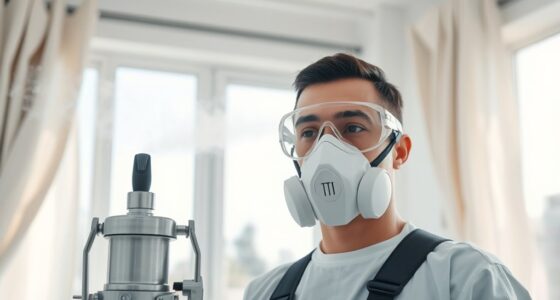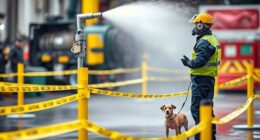To handle flammable coatings and solvents safely, store them in approved, clearly labeled containers kept tightly closed in cool, dry areas away from heat or ignition sources. Use proper ventilation and work in well-ventilated spaces to disperse vapors. Always wear personal protective equipment and follow manufacturer guidelines. Keep ignition sources away and make certain storage cabinets are designed for flammables. Continuing will give you more essential safety tips to prevent accidents and protect yourself.
Key Takeaways
- Store flammable coatings and solvents in approved, clearly labeled containers away from heat and ignition sources.
- Use dedicated, ventilated storage cabinets to contain leaks and prevent vapor accumulation.
- Ensure proper ventilation with local exhaust systems and natural airflow to disperse vapors effectively.
- Always wear personal protective equipment and follow manufacturer safety data sheets during handling.
- Keep work areas free of static, open flames, and electrical sparks to minimize fire risk.

Handling flammable coatings and solvents safely is vital to prevent fires, injuries, and health hazards in your work environment. One of the most important steps you can take is guaranteeing proper storage of these materials. Store all flammable coatings and solvents in approved, clearly labeled containers that are designed for flammable liquids. Keep these containers tightly closed when not in use to reduce vapor release, and place them in cool, dry areas away from heat sources, open flames, or sparks. Avoid stacking containers too high to prevent accidental spills or falls. Additionally, store flammable materials separately from oxidizers, acids, or other incompatible substances to minimize the risk of dangerous reactions. Having designated storage cabinets specifically built for flammables can further enhance safety by containing potential leaks and preventing ignition sources from coming into contact with the chemicals.
Ventilation measures play a vital role in handling flammable coatings and solvents safely. Adequate ventilation helps disperse vapors that are inherently combustible and toxic, reducing the risk of accumulation and potential ignition. When working indoors, use local exhaust ventilation systems, such as hoods or fans positioned close to the work area, to quickly remove vapors at their source. Regularly check and maintain these systems to guarantee they’re functioning properly. If natural ventilation is used, open windows and doors to promote airflow, but always combine this with mechanical ventilation for better control. Never work with flammable coatings or solvents in confined spaces without proper ventilation, as vapors can build up rapidly and reach dangerous concentrations. In addition to active ventilation, consider installing explosion-proof exhaust fans and electrical fixtures in areas where flammable materials are stored or used. These measures greatly diminish the chance of vapor ignition. Recognizing the importance of proper projector safety practices can further reduce risks associated with chemical handling.
Furthermore, always follow manufacturer guidelines and safety data sheets when handling these substances. Use personal protective equipment, such as gloves and respirators, to prevent skin contact and inhalation of fumes. Keep ignition sources, like open flames, electrical switches, or static electricity, away from the work zone. Regular training on chemical safety and emergency procedures also helps you stay prepared for accidental spills or fires. By combining proper storage practices with effective ventilation measures, you create a safer environment and considerably reduce the risk associated with handling flammable coatings and solvents. Remember, safety isn’t just about compliance; it’s about protecting yourself, your colleagues, and your workspace from preventable hazards.
Frequently Asked Questions
What Are the Most Common Signs of Flammable Coating Leaks?
You’ll notice common signs of flammable coating leaks through leak detection methods and odor indicators. If you detect a strong, chemical smell or unusual odors near your work area, it’s a warning sign. Additionally, look for visible leaks, drips, or puddles of coating material. Regularly inspecting equipment and using proper sensors can help you spot leaks early, preventing potential hazards and ensuring safe handling of flammable substances.
How Often Should Flammable Solvent Storage Areas Be Inspected?
You should conduct storage maintenance inspections of flammable solvent areas at least weekly, or more often if conditions warrant. Regular inspection frequency guarantees you catch leaks, spills, or deterioration early. During each check, look for signs of damage, proper labeling, and safe storage practices. Consistent inspection frequency helps you maintain a safe environment, prevent accidents, and comply with safety regulations. Always document your inspections for accountability and ongoing safety improvements.
Can Flammable Coatings Be Safely Used Outdoors During Rain?
You can safely use flammable coatings outdoors during rain if you choose rain-resistant coatings designed for weatherproof application. Make certain the coating is specifically formulated to withstand rain and moisture, and apply it during dry weather conditions. Follow manufacturer instructions carefully, and wait for proper drying and curing times before exposing the surface to rain. This approach helps maintain safety and ensures your coating functions effectively in outdoor environments.
What Personal Protective Equipment Is Recommended When Handling Solvents?
When handling solvents, you need the right protective gear to stay safe. You should wear respiratory protection to prevent inhaling harmful fumes and protective gloves to shield your skin from burns or irritation. Skipping this gear risks serious injury or health issues. Always make certain your respirator fits properly and gloves are resistant to solvents. Don’t cut corners—your safety depends on it, especially when dealing with these dangerous substances.
Are There Environmentally Friendly Alternatives to Traditional Flammable Coatings?
Yes, there are environmentally friendly alternatives to traditional flammable coatings. You can opt for eco-friendly finishes that are designed to reduce environmental impact, such as water-based or low-VOC options. Additionally, using biodegradable solvents minimizes pollution and eases disposal. These alternatives help you maintain safety and sustainability, reducing health risks and environmental harm while still achieving high-quality results in your projects.
Conclusion
Remember, handling flammable coatings and solvents is like walking a tightrope—you need focus, care, and respect for the danger beneath your feet. Keep flames at bay, store wisely, and wear your safety gear like armor. By staying vigilant, you’re the captain steering clear of stormy seas. When you prioritize safety, you turn a potential disaster into a smooth voyage, letting your work shine without risking the sparks that could ignite chaos.










